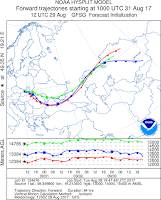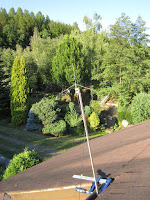Time: 6:00 GMT (8:00 CEST)
Place: Roznov pod Radhostem, CZ
Live Tracking: https://tracker.habhub.org and https://aprs.fi
RTTY
Callsign: TT7F3
Frequency: 434.374MHz
Params: 100 baud, 450Hz shift, 8n2
Preceded by: 5 slow blips (~6s)
Packet: callsign, count, time, date, latitude, longitude, altitude, sats, Vsolar, Vbatt, Tmcu, Ttx
Example: $$TT7F3,13,15:13:32,20170719,49.46868,18.15101,408,6,899,3950,30,29*FB99
APRS
Callsign: OK7DMT-7
Frequency: Geofenced local APRS frequencies
Packet: Base-91 position and telemetry, Backlogged position and telemetry in Comment section
Example: !/5KyHS)='OJ5W 1F94!5MI,S(LWHC!+=7+;0c!'|!4!-<x+S1%!(!$|
Initial Prediction: 2017-08-29
Power Scheme
If the voltage on the supercapacitors is higher than 3.8V, the tracker transmits APRS once per minute and RTTY once per two minutes. If the supercapacitor voltage gets below its limit, the tracker transmits only APRS packets once per two minutes, and the RTTY transmission stops.
Tracker
To power this tracker, I decided to build two parallel branches of 52x39mm solar cells angled at 45° to ground facing opposite directions. Dave VE3KCL pointed out that setting up the cells as shown in The Low Power Setup could force the tracker to rotate like a propeller. To void that, I interleaved the two branches at the cost of a little more wiring. The LTC3105 was set to output 4.05V (Rmppc - 91kΩ) charging two 40F supercapacitors in series. This meant the tracker wouldn't take advantage of the full capacity, but it took care of the need to balance the two supercaps. For the antenna two 492mm pieces of guitar string were solder to the tracker to create a 2-meter dipole. The tracker was laid out with ESD foam and wrapped in black electrical tape.
Mass: 31.9g
Software
The main function running the tracker can be found in ARM_TT7F3.c on GitHub. The code structure is similar to TT7F1 with added Watchdog. The bitfield in an APRS packet indicates whether it is in the high altitude Airborne mode (NAV), whether it acquired GPS fix (FIX), whether a new backlog was written to the flash memory in this cycle (BCK), and whether the tracker currently runs the slower, APRS only, power saving cycle (PSM). An example data set extracted from received APRS packets can be seen in the chart above. It was a stormy day and I had to hide the tracker under a roof at times.
Balloon
The balloon is the second finished envelope described in The Superpressure Balloons blog post. It was made from 50 micron PE/PA/EVOH/PA/PE material and it is 1.84m in diameter. The estimated stretch is 1.83 Gamma. The chart above shows the stretching profile for this specific envelope. A meridional weld opening had to be repaired after the first stretching. The second attempt took about 16 hours.
Expected Float Altitude: 15400m
Expected Ascent Rate: 1m/s
Expected Superpressure: 1570Pa (at 19°C supertemperature)
Gas: Hydrogen
Free Lift: 15g
I managed to fill the balloon to 15.5g free lift. The launch itself went smoothly. I also tried to improve the RTTY reception by temporarily installing a ground plane antenna with an LNA on the roof. It worked well until the balloon reached about 5.5km in altitude and the voltage on the tracker's capacitors fell below 3.8V for some reason. Below this level the tracker ceases RTTY transmissions and switches to APRS in two minute cycles only. In this manner, the tracker continued all the way to sunset. The last received data show some wobbling in the balloon's altitude (cooling of the gas after sunset?). The predicted path had the balloon over Romania for the following day where APRS transmission is turned off. At the time of writing several days later the tracker hasn't showed up anywhere along the predicted path and is considered no longer afloat.
Data
APRSfi_TT7F3.txt - collected raw packets.
Python parser of APRS.fi raw packet format.
The positional and telemetry data extracted from received APRS packets and decoded backlogs:
































No comments:
Post a Comment